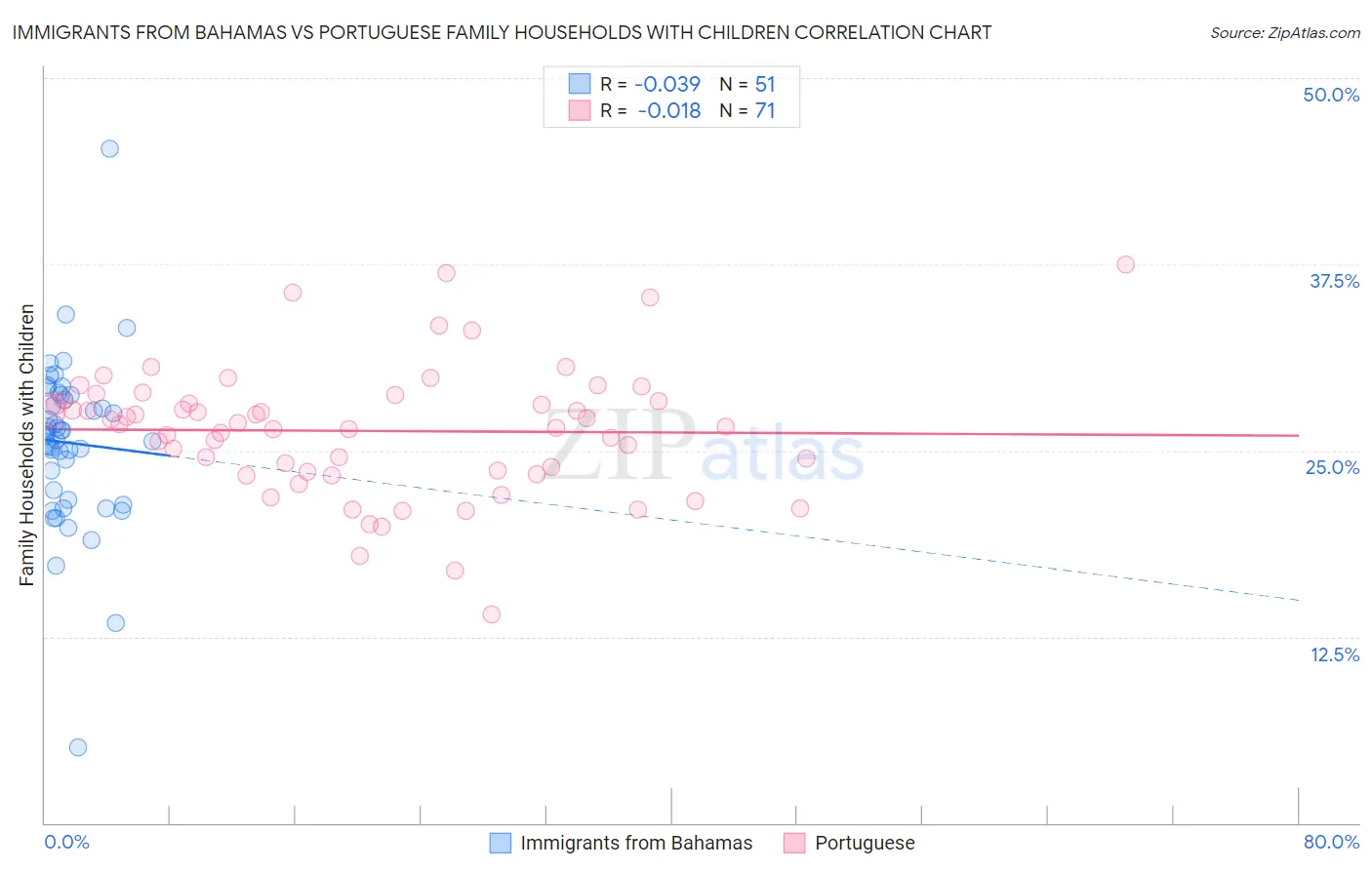Immigrants from Bahamas vs Portuguese Family Households with Children
COMPARE
Immigrants from Bahamas
Portuguese
Family Households with Children
Family Households with Children Comparison
Immigrants from Bahamas
Portuguese
26.3%
FAMILY HOUSEHOLDS WITH CHILDREN
0.1/ 100
METRIC RATING
304th/ 347
METRIC RANK
27.6%
FAMILY HOUSEHOLDS WITH CHILDREN
77.8/ 100
METRIC RATING
151st/ 347
METRIC RANK
Immigrants from Bahamas vs Portuguese Family Households with Children Correlation Chart
The statistical analysis conducted on geographies consisting of 104,549,711 people shows no correlation between the proportion of Immigrants from Bahamas and percentage of family households with children in the United States with a correlation coefficient (R) of -0.039 and weighted average of 26.3%. Similarly, the statistical analysis conducted on geographies consisting of 449,747,552 people shows no correlation between the proportion of Portuguese and percentage of family households with children in the United States with a correlation coefficient (R) of -0.018 and weighted average of 27.6%, a difference of 5.0%.

Family Households with Children Correlation Summary
| Measurement | Immigrants from Bahamas | Portuguese |
| Minimum | 5.1% | 14.0% |
| Maximum | 45.3% | 37.5% |
| Range | 40.2% | 23.5% |
| Mean | 25.5% | 26.3% |
| Median | 26.0% | 26.7% |
| Interquartile 25% (IQ1) | 21.7% | 23.5% |
| Interquartile 75% (IQ3) | 28.7% | 28.4% |
| Interquartile Range (IQR) | 7.1% | 4.9% |
| Standard Deviation (Sample) | 5.7% | 4.4% |
| Standard Deviation (Population) | 5.6% | 4.3% |
Similar Demographics by Family Households with Children
Demographics Similar to Immigrants from Bahamas by Family Households with Children
In terms of family households with children, the demographic groups most similar to Immigrants from Bahamas are Guyanese (26.3%, a difference of 0.030%), Bermudan (26.3%, a difference of 0.040%), Immigrants from Guyana (26.3%, a difference of 0.050%), Serbian (26.4%, a difference of 0.080%), and Immigrants from Trinidad and Tobago (26.4%, a difference of 0.090%).
| Demographics | Rating | Rank | Family Households with Children |
| Armenians | 0.1 /100 | #297 | Tragic 26.4% |
| Immigrants | Western Europe | 0.1 /100 | #298 | Tragic 26.4% |
| Trinidadians and Tobagonians | 0.1 /100 | #299 | Tragic 26.4% |
| Paiute | 0.1 /100 | #300 | Tragic 26.4% |
| Immigrants | Trinidad and Tobago | 0.1 /100 | #301 | Tragic 26.4% |
| Serbians | 0.1 /100 | #302 | Tragic 26.4% |
| Immigrants | Guyana | 0.1 /100 | #303 | Tragic 26.3% |
| Immigrants | Bahamas | 0.1 /100 | #304 | Tragic 26.3% |
| Guyanese | 0.1 /100 | #305 | Tragic 26.3% |
| Bermudans | 0.1 /100 | #306 | Tragic 26.3% |
| West Indians | 0.0 /100 | #307 | Tragic 26.3% |
| Lumbee | 0.0 /100 | #308 | Tragic 26.3% |
| Immigrants | Somalia | 0.0 /100 | #309 | Tragic 26.3% |
| Marshallese | 0.0 /100 | #310 | Tragic 26.2% |
| Colville | 0.0 /100 | #311 | Tragic 26.2% |
Demographics Similar to Portuguese by Family Households with Children
In terms of family households with children, the demographic groups most similar to Portuguese are Argentinean (27.6%, a difference of 0.020%), Ethiopian (27.6%, a difference of 0.030%), Immigrants from Moldova (27.6%, a difference of 0.040%), Osage (27.6%, a difference of 0.040%), and Menominee (27.6%, a difference of 0.040%).
| Demographics | Rating | Rank | Family Households with Children |
| Brazilians | 79.6 /100 | #144 | Good 27.7% |
| Immigrants | Chile | 79.5 /100 | #145 | Good 27.7% |
| Basques | 79.5 /100 | #146 | Good 27.7% |
| Immigrants | Moldova | 79.1 /100 | #147 | Good 27.6% |
| Osage | 79.0 /100 | #148 | Good 27.6% |
| Menominee | 78.9 /100 | #149 | Good 27.6% |
| Argentineans | 78.5 /100 | #150 | Good 27.6% |
| Portuguese | 77.8 /100 | #151 | Good 27.6% |
| Ethiopians | 77.0 /100 | #152 | Good 27.6% |
| Immigrants | Cabo Verde | 75.6 /100 | #153 | Good 27.6% |
| Icelanders | 75.3 /100 | #154 | Good 27.6% |
| Comanche | 74.8 /100 | #155 | Good 27.6% |
| Hungarians | 74.6 /100 | #156 | Good 27.6% |
| Indians (Asian) | 71.6 /100 | #157 | Good 27.6% |
| Romanians | 70.8 /100 | #158 | Good 27.6% |